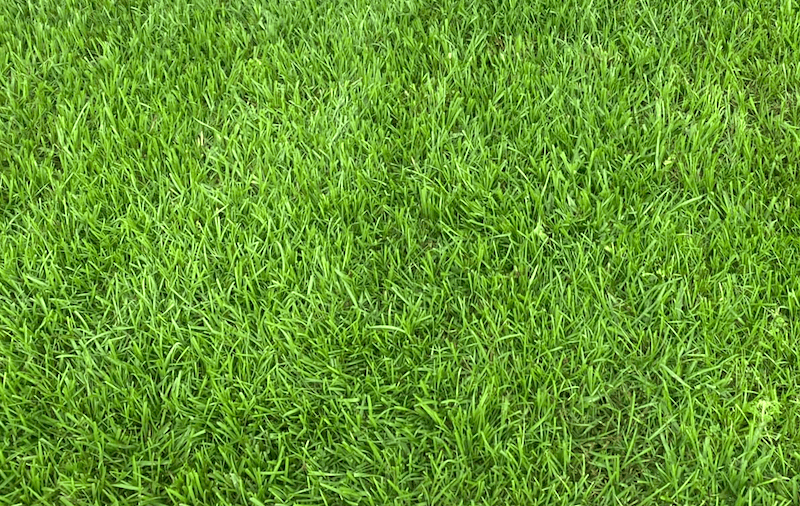In this guide to Bahia, we'll discuss everything from cost to best mowing height while also looking at the pros and cons. By the end, you'll be perfectly positioned to know whether it's the right sod type for you.
Bahiagrass is easy to maintain, drought-tolerant, and thrives in sandy or infertile soils. Let's explore this grass and why it might be the perfect choice for our lawns, pastures, or erosion control projects.
Native to South America, Bahiagrass was introduced to the United States in the early years of the 20th century. Over time, it has become a popular option in the southeastern US due to its adaptability in a wide range of conditions. We'll dive into the benefits, growth habits, and care required for this hardy grass species.
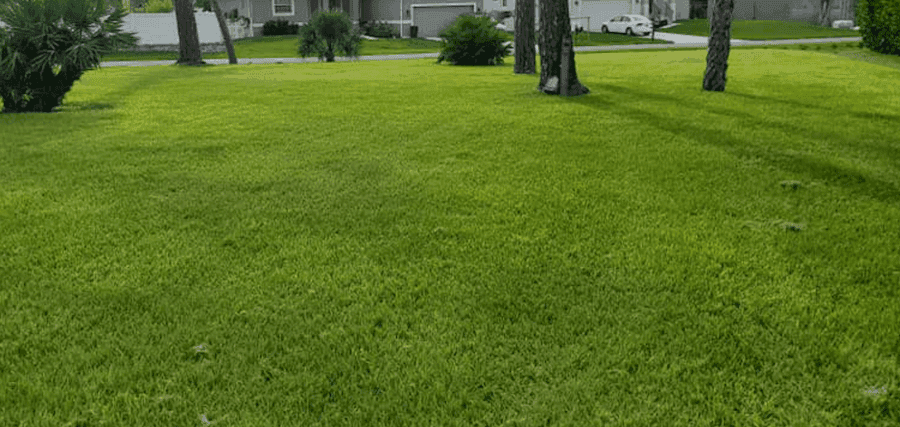
What Is Bahiagrass?
Bahiagrass AKA "Bahia" is a warm-season perennial grass that originates from South America. It's a popular choice for lawns, pastures, and hay production, especially in the southeastern United States. With its extensive root system, Bahiagrass tolerates drought and adapts well to sandy or acidic soils.
One of the reasons we love Bahiagrass is its low maintenance requirements. It doesn't need frequent watering or fertilization, making it a great choice for those looking for an easy-to-care-for lawn. Additionally, Bahiagrass has a natural resistance to pests and diseases, helping maintain its healthy appearance without the need for chemicals. We also appreciate its ability to grow well in areas with limited sunlight.
A unique feature of Bahiagrass is its tall seed head, which resembles a small "Y." This distinctive characteristic makes it easy to identify, even from a distance. When establishing a new lawn or pasture, seeded Bahiagrass varieties such as 'Pensacola' and 'Argentine' are commonly used.
Is Bahia a Good Grass to Grow?
Bahiagrass is a popular choice for many different environments. Let's take a look at the benefits and possible drawbacks of growing this grass.
Pros of Bahiagrass:
Drought Tolerant: Bahiagrass can survive in dry conditions. It's great for areas that don't get a lot of rain.
Low Maintenance: We don't need to fuss over it too much. It can handle various soil types, and doesn't require constant watering.
Erosion Control: Bahiagrass has a deep root system, which helps stabilize the soil. It's an excellent choice for preventing soil erosion.
Pest Resistant: Insects and other pests don't bother it too much. We can spend less time and resources dealing with pests.
Cons of Bahiagrass:
Coarse Texture: It's not the softest grass to walk on. Homeowners looking for a soft, lush lawn may want to consider other options.
Spreads slowly: Bahiagrass takes a while to grow and spread, so it might take some patience to see results.
Requires sun: This grass type thrives in full sun. It's not the best option for shady areas.
Less Appealing Aesthetically: Some people find its appearance less attractive than other grass types. It depends on personal preference.
In conclusion, Bahiagrass is a good grass to grow depending on our specific needs. It's worth considering due to its drought tolerance and low maintenance, but may not be the best for those who value aesthetics and soft texture.
Bahiagrass Features & Facts
Appearance and Growth Habits
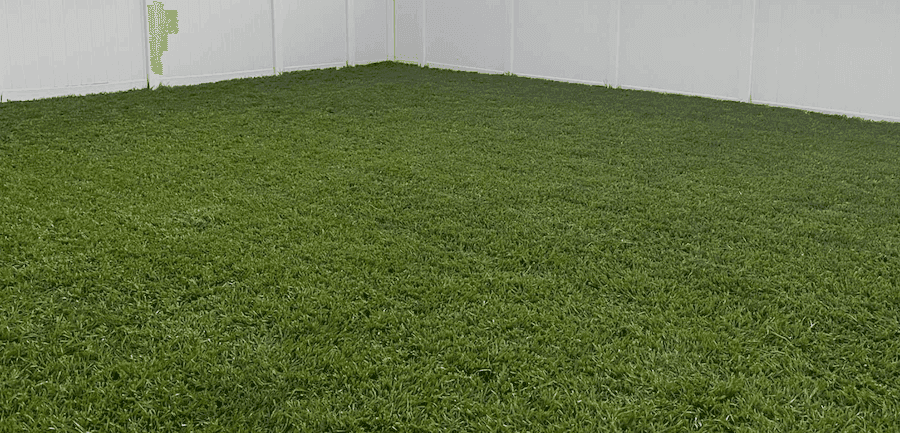
Bahiagrass is a warm-season grass with a low-growing and coarse texture. Its growth pattern features a tall, slender stalk called a raceme, which gives it a unique appearance.
One key advantage of Bahiagrass is its drought tolerance. It can withstand long periods without water, making it a popular choice for regions with dry, hot climates. It thrives especially well in sandy soils, with less irrigation and maintenance compared to other warm-season grasses.
Adaptability and Climate Requirements
Bahiagrass is native to the southeastern United States, where it enjoys a warm climate. It is considered a warm-season grass, meaning it actively grows during the warmer months of the year. We can find it prospering in regions with hot summers and mild winters, making it an excellent choice for lawns in those areas.
Its adaptability and climate requirements make Bahiagrass a suitable option for a wide range of environments, particularly in the southeastern United States. The grass's resilience to drought and ability to tolerate high temperatures allow it to thrive in these regions.
Soil Types and Sunlight Preferences
Bahiagrass can grow in a wide range of soil types, from sandy soil to acidic soil, and even in poor soil conditions. It prefers well-drained sandy soils and can tolerate nutrient deficiencies and acidity better than other warm-season grasses. Here's a quick summary of its soil and sunlight preferences:
Soil type: Prefers sandy and acidic soils, but can adapt to a wide range of soil types.
Sunlight: It flourishes in full sun, but can also tolerate some shade.
Bahiagrass Varieties
Bahiagrass is a popular choice for lawns, especially in warmer regions. There are several varieties of Bahiagrass, each with its own unique set of characteristics and benefits.
Pensacola Bahiagrass is one of the most common varieties, known for its fine texture and rapid growth. It's adaptable to various soil conditions and is also more cold-tolerant than other types. This makes it an excellent choice for homeowners who want a low-maintenance lawn.
Level Up Your Lawn Skills
Once per week we'll send you an interview from someone who has mastered the art of lawn care.
Argentine Bahiagrass has a darker green color and wider, flat leaves, providing a lush appearance. This variety is also highly resistant to pests and diseases, making it a durable option for lawns. However, it takes a bit longer to establish than Pensacola, so patience is key during the initial growth period.
Tifton 9 Bahiagrass is a newer variety developed for its improved drought tolerance and high-quality forage production. Although designed with cattle grazing in mind, this deep-rooted grass is also a hardy option for lawns in areas prone to dry conditions.
In addition to these, there are other types of sod that may be more suitable for specific growing zones and preferences. You can explore a list of sod types to find the best one for your needs.
Each variety of Bahiagrass offers its own advantages, making it a versatile option for lawns. Consider your local climate, soil conditions, and personal preferences when choosing the right Bahiagrass for your lawn.
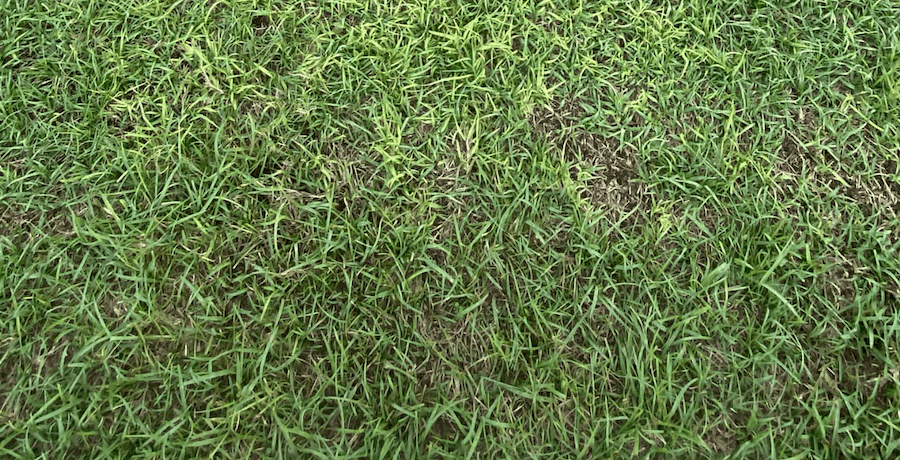
Main Uses for Bahiagrass
Bahiagrass is a versatile grass species with many practical uses. Its hardy nature and ability to thrive in a variety of conditions make it an excellent choice for a range of purposes. In this section, we'll explore some of the most common uses for Bahiagrass.
Landscaping and Lawns Bahiagrass is ideal for creating low-maintenance lawns and landscaping solutions. It can tolerate drought and poor soil conditions, making it a popular choice for areas with limited rainfall or nutrient-deficient soils. Moreover, its quick establishment and dense growth habit help prevent soil erosion. Homeowners love Bahiagrass lawns because they require significantly less water and fertilizer than other grass types.
Pasture and Forage We can often find Bahiagrass in pastures, where it serves as an essential forage grass for livestock. It's highly preferred for cattle, horses, and goats, thanks to its nutritional value, high yield, and persistent growth throughout the growing season. Plus, the deep root system helps withstand grazing pressure, maintaining a healthy pasture under normal grazing conditions.
Wildlife Habitat Bahiagrass fields also provide valuable habitat for native wildlife species. Deer, quail, and other game birds benefit from the cover and food sources available in these grassy areas. It's ideal for creating food plots for hunting and maintaining wildlife habitats on private or public lands.
Erosion Control and Reclamation Finally, Bahiagrass is prized for its ability to stabilize soil and prevent erosion. It's commonly used in land reclamation projects, roadways, and embankments where erosion control is needed. The vigorous root system binds the soil, reducing erosion from water and wind, while the dense foliage slows down water flow, minimizing soil disruption.
As you can see, Bahiagrass serves a variety of purposes across different industries and applications. Its hardy nature, low maintenance requirements, and adaptability make it a go-to choice for many people in need of a reliable, attractive, and environmentally friendly grass solution.
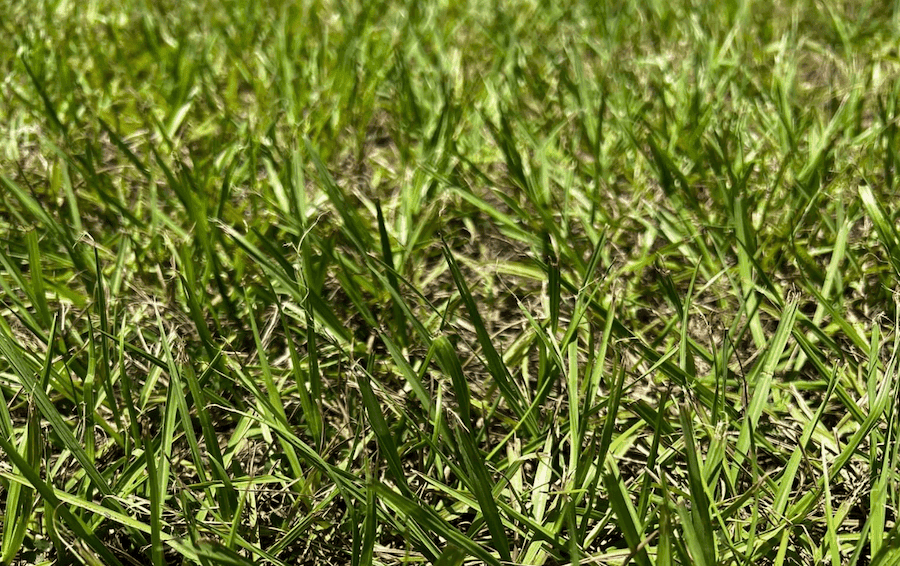
Care & Maintenance
How to Lay and Establish Bahia
To establish a healthy Bahiagrass lawn, you can use seeds or stolons. Plant seeds in spring or early summer for optimal results, keeping in mind that Pensacola and Argentine varieties differ in growth characteristics. Make sure soil is well-prepared to enhance establishment and growth.
Watering Practices
Bahiagrass excels in drought tolerance, but proper watering is still crucial during establishment. Irrigate the lawn to keep the soil moist until seeds germinate. Once established, reduce watering frequency, allowing the soil to dry slightly between sessions.
Fertilization Schedule
Fertilize your Bahiagrass lawn twice per year: once in spring and again in early summer. Use a fertilizer that meets the specific nutrient needs of your soil. Iron may be required to enhance the lawn's color. Be careful not to over-fertilize, as it can promote unwanted weed growth.
Mowing Guidelines
Regular mowing is key to maintaining a neat and attractive lawn. Mow Bahiagrass at a height of 3 to 4 inches; this encourages a deep root system, improving drought tolerance. As a low-maintenance turfgrass, it requires less frequent mowing than other species.
Weed and Pest Management
Weeds and pests can be controlled through both cultural and chemical methods. Practices such as mowing and fertilization help promote a healthy and dense Bahiagrass turf, deterring weed growth. If necessary, use selective herbicides instead of non-selective options like Roundup. For pest control, focus on mole cricket management to minimize damage to your lawn.
Thatch Control and Aeration
Thatch buildup can prevent water, air, and nutrients from reaching your Bahiagrass roots. Remove excess thatch and aerate the lawn to improve overall health. This also encourages the grass to spread through its rhizomes, ensuring a dense and attractive turf.
Winter Care (if applicable)
Since Bahiagrass enters dormancy during winter, overseed with cool-season grasses to maintain green coverage. Gradually reduce watering as temperatures drop, and avoid fertilizing during winter months. This helps keep your Bahiagrass strong until spring resumes active growth.
Pros & Cons
Bahiagrass is a popular choice for lawns, pastures, and roadsides. We're here to discuss its pros and cons to help you make an informed decision.
Pros:
Drought tolerance: Bahiagrass has deep roots, allowing it to survive in dry conditions. You won't have to worry about watering it often.
Low maintenance: It requires less mowing compared to other grasses, which means less work for us.
Pest resistance: Bahiagrass isn't a favorite for many insects, making it more resistant to pests.
Soil adaptability: It grows well even in poor, sandy soils. You won't need to spend much on soil amendments.
Cons:
Texture: Bahiagrass has a coarse texture that might not appeal to everyone. Some people prefer soft, fine-bladed grasses.
Slow growth: It takes time for it to establish and spread, leaving bare, brown spots in the lawn until it thickens up.
Limited cold tolerance: Bahiagrass struggles in freezing temperatures. It might not be ideal in areas with harsh winters.
Less attractive appearance: When compared to other grasses like Zoysia, Bahiagrass might not look as lush and green.
Now that you know the pros and cons of Bahiagrass, you can make a choice that suits your needs and preferences.
Bahiagrass Costs
Bahiagrass is an affordable option for lawns and pastures. Let's dive into the costs associated with planting and maintaining this turf.
Seed costs: Bahiagrass seeds usually range between $3 to $5 per pound. For an average-sized lawn, we might need around 5 pounds of seed, totaling around $15 to $25.
Bahia Sod costs: If we prefer to use sod instead of seeds, the cost is usually between $0.30 to $0.75 per square foot. For a 1000 square foot lawn, we can expect to spend between $300 to $750.
Fertilizer costs: Fertilizing Bahiagrass is essential for proper growth. A 50-pound bag of fertilizer typically costs around $15 to $45, depending on the nutrients and brand. We might need to apply it 2 to 4 times a year.
Mowing and maintenance: Bahiagrass should be mowed once every two weeks during its growing season. We can also keep costs low by using a basic push mower or choose to invest in a more expensive, self-propelled mower.
Watering costs: Bahiagrass is drought-tolerant, so we won't need to water it as frequently as other types of grass. This can save us money on our water bill in the long run.
Keep in mind that the costs above may vary depending on our specific region and the quality of products we choose. By planting and maintaining Bahiagrass, we can create an attractive and budget-friendly lawn or pasture.
Bahia vs. Other Types of Grass
When comparing Bahiagrass to other types of grass, we often look at traits like low-maintenance, appearance, and suitability for different regions. In this section, we'll cover how Bahiagrass stacks up against some common grass species like Bermudagrass, Tall Fescue, and others.
Bahiagrass is a low-maintenance turf, making it a popular option among homeowners and landowners alike. Unlike Bermuda, which requires more extensive care and maintenance, Bahiagrass can thrive with less attention. For those with limited time, resources, or expertise, Bahiagrass is an ideal choice.
When it comes to performance in various climates, Argentine Bahiagrass stands out among the Bahiagrass varieties due to its adaptability. This variety can handle both drought and humidity, making it suitable for many regions. On the other hand, Bermudagrass does prefer warmer climates, and Tall Fescue is better suited for cool-season regions.
As a turfgrass, Bahia is ideal for lawns and recreational areas like parks, sports fields, and golf courses. However, the appearance of Bahiagrass is not as uniform and pristine as other lawn grasses. Bermudagrass and Tall Fescue both offer finer textured blades, giving them a more polished appearance. That said, Bahiagrass is a tough, robust grass species, making it an excellent option for high-traffic areas or where soil erosion can be a problem.
In terms of cost, Bahiagrass is an affordable, cost-effective option. It is less expensive than high-maintenance grass varieties, and its ability to withstand wear and tear makes it a solid long-term investment.
As a pasture grass, Bahiagrass is also beneficial for livestock grazing. It serves as a nutritious and sustainable perennial grass for animals, contributing to healthier pastures overall. Although Bermudagrass and Tall Fescue also work as pasture grasses, their specific requirements and adaptability may make them less suitable for certain grazing situations.
To sum up, Bahia is an excellent choice for low-maintenance turf, versatile adaptability to various climates, and cost-effectiveness. While its appearance may not be as refined as other lawn grasses, and it isn't necessarily the best pasture option, it offers a dependable lawn or recreational area solution that can withstand the test of time.
Frequently Asked Questions
What is the best fertilizer for Bahiagrass?
We recommend a slow-release fertilizer with a balanced ratio of nitrogen, phosphorus, and potassium (N-P-K). A good choice would be a 16-4-8 fertilizer, applied in the spring and summer months. Remember, it's important to follow the package instructions to avoid over-fertilizing.
Is Pensacola Bahiagrass suitable for a lawn?
Yes, Pensacola Bahia is a great option for lawns. It's a low-maintenance grass that's well suited for sandy, acidic soils. It also has good resistance to pests and diseases. However, be aware that it's not as soft underfoot as some other grass types, and may not be the best choice for high-traffic areas.
How do you control Bahiagrass in pastures?
To manage Bahiagrass in pastures, consider using a combination of mowing, selective herbicides, and proper grazing practices. For example, mowing the grass before seedheads form can help prevent spreading. Additionally, selective herbicides can target unwanted Bahiagrass while leaving other pasture plants unharmed. Lastly, proper grazing practices, such as rotational or strip grazing, can help maintain healthy pastures.
How does Bahia tolerate drought?
Bahiagrass is well-known for its drought tolerance. Its deep root system allows it to access water even during dry periods, making it an excellent choice for areas prone to drought. However, during prolonged droughts, Bahiagrass can go dormant, turning a straw-like brown color. Don't worry, it will usually recover once it receives adequate water.
What are the key differences between Bahiagrass and Bermuda grass?
Some key differences between Bahiagrass and Bermuda grass include their appearance, soil preference, and maintenance requirements. It has a coarser texture and wider leaf blades than Bermuda grass. It also prefers sandy, acidic soils, while Bermuda grass is more adaptable to various soil types. Bahiagrass requires less frequent mowing and generally has fewer disease and pest problems, but Bermuda grass may have a finer, softer texture that's more appealing for lawns and sports fields.
Is Bahiagrass invasive or harmful to the environment?
Bahiagrass is not considered invasive or harmful to the environment. It's a valuable turf grass and forage option for many regions, especially in areas with sandy soils or prone to drought. However, it's important to manage it properly, as it can spread if allowed to produce seedheads. Always follow best practices in lawn and pasture management to keep Bahiagrass under control.
Bahia versus other types of sod
- Bahia vs. Bermuda comparison →
- Bahia vs. Buffalo comparison →
- Bahia vs. Zoysia comparison →
- Bahia vs. Tall Fescue comparison →
- Bahia vs. Kentucky Bluegrass comparison →
- Bahia vs. Perennial Ryegrass comparison →
- Bahia vs. St. Augustine comparison →
- Bahia vs. Centipede comparison →
- Bahia vs. Fine Fescue comparison →
Level Up Your Lawn Skills
Once per week we'll send you an interview from someone who has mastered the art of lawn care.

